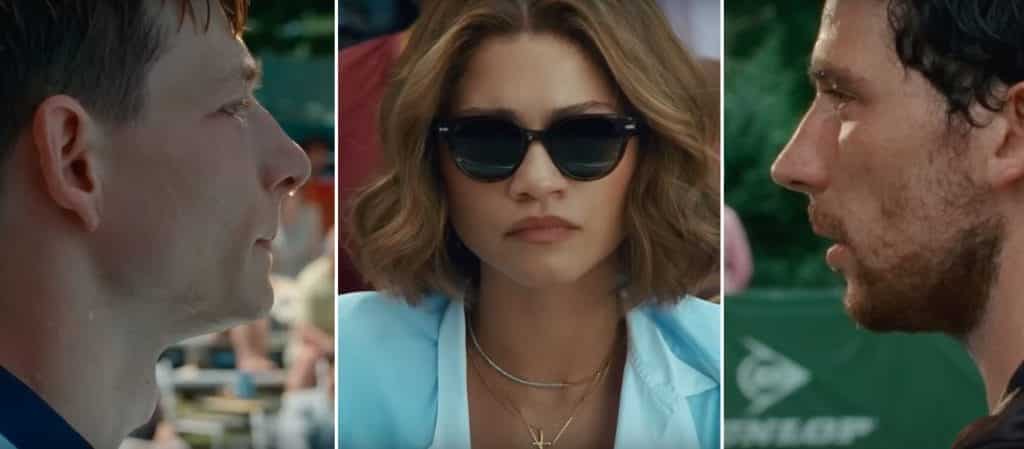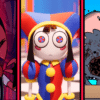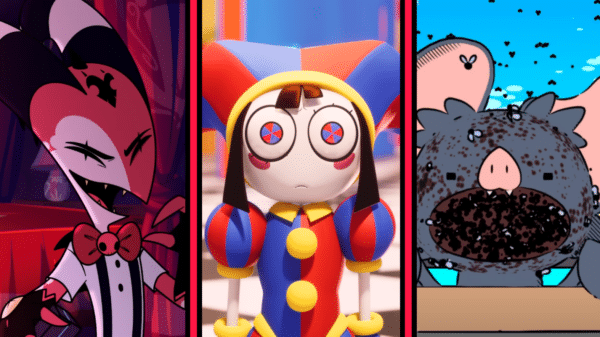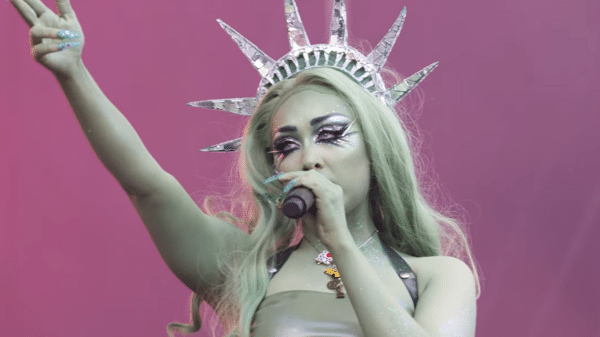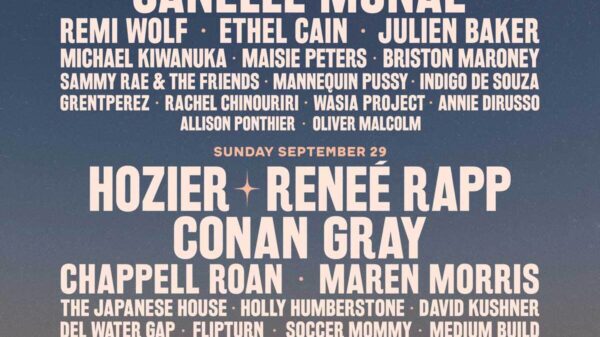The thesis statement of Challengers is given by Tashi Duncan (Zendaya) about thirty minutes into Luca Guadagnino‘s eighth feature film: “Tennis is a relationship.” When an incredulous Patrick (Josh O’Connor) asks if this is what Tashi was having with her opponent earlier in the day, she says: “We understood each other completely. So did everyone watching.”
Tashi introduces this concept to budding players Patrick Zweig and Art Donaldson (Mike Faist), just on the cusp of going pro but still cruising around junior Slams and eating burgers, drinking beer, and smoking cigarettes. She is a great deal more serious about this stuff than they are, and Patrick’s insecurity about the cavern between their professionalism and corporate attention is shown in his poorly masked disdain for her Adidas advertisements and overall aura of success. He admires her, sure, but he envies her more. Art plainly wants her approval, and for her to know that he recognises her talent. Point: Donaldson.
Scriptwriter Justin Kuritzkes does an excellent job of incorporating Tashi’s description of what tennis is throughout the script. It is as much of an indication that there is a new understanding of their relationships with one another as the overlaid captions of ‘Set Break’, ‘Second Set’, and ‘Third Set’ indicate that a new act has begun.
You’re Always Talking About Tennis!
Is what Lily (A.J. Lister) says to her parents, Art and Tashi. My God, kid, of course they are! They make millions off of it. Go watch Spiderverse.
In seriousness, Lily raises an interesting point early on in the film. What do Art and Tashi do other than talk about tennis? A lot of the time, they don’t seem to talk at all. We see little intimacy, and Tashi functions more like a manager than a wife. As we come to understand, this is exactly what it is. Art and Tashi are partners in building a career together first, and any intimacy that we are allowed to see is incidental; it is less “Let’s do it!” and more “Oh, well, if we’re here…”
And yet, what we see of Tashi and Art’s partnership fits the bill for what Tashi considers an intimate relationship: tennis. Especially since Art is delivering results because of her training. It is implied that Art is where he is (a six-time Grand Slam winner) because of her. Tashi gets to have intimacy with Art, and various other players, so long as he has the fire burning to put his all into his side of the court. Tashi and Art don’t need to be physically intimate: symbiotic success is enough.
The problem arises when Art is no longer giving himself to the game in the way Tashi needs him to. There is nothing happening for Tashi anymore. I suppose it’s time to talk about what Guadagnino allows us to see of Tashi and Patrick’s relationship.
Are We Talking About Tennis?
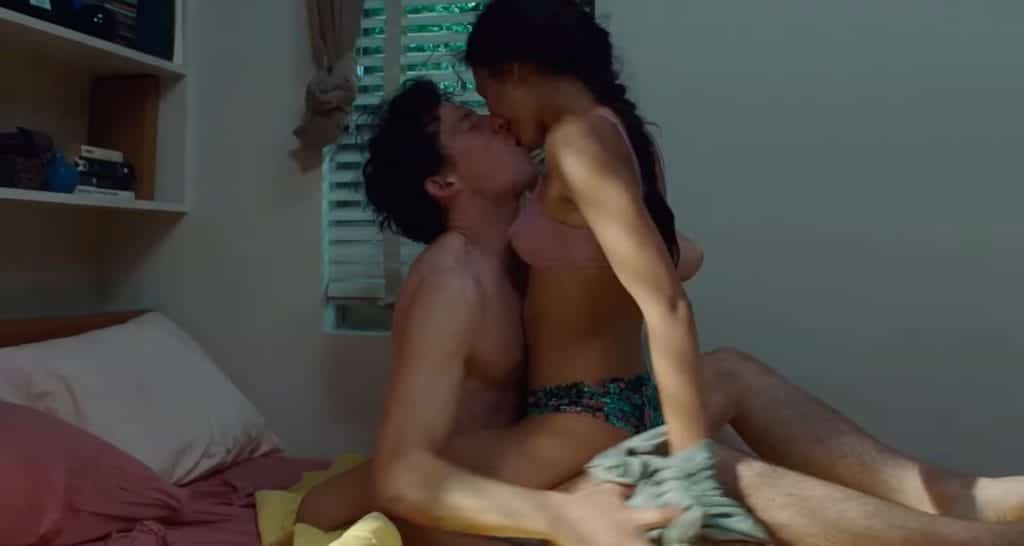
The next time we hear the phrase “talking about tennis” is when Patrick and Tashi are getting it on, as it were, in her Stanford dorm room, twelve years earlier. To get in the mood, they talk about… Art. Figures. At least, Patrick is trying to get in the mood. Tashi (fairly, probably) uses this as a moment to give him her two cents about why he is losing his matches on the professional tour (“You always think you’ve won before the match is over”). From the way Patrick is responding, it is fair to assume that this is a sex thing.
Patrick gets off on humiliation? Quelle surprise. Yet something isn’t sitting right with him about Tashi’s “dirty talk”, so he clarifies: “Are we talking about tennis?” To which Tashi responds:
We’re Always Talking About Tennis.
Patrick tries to disagree, but Tashi is not interested in innuendo. She isn’t trying to get Patrick in the mood by putting him down based on his tennis skills. Tashi genuinely wants to talk about improvement—this is what is erotic to her, and how she constitutes intimacy. Obviously, not so much to Patrick. He would rather be told that he sucks on a conceptual level, but Tashi wants to be “completely understood.”
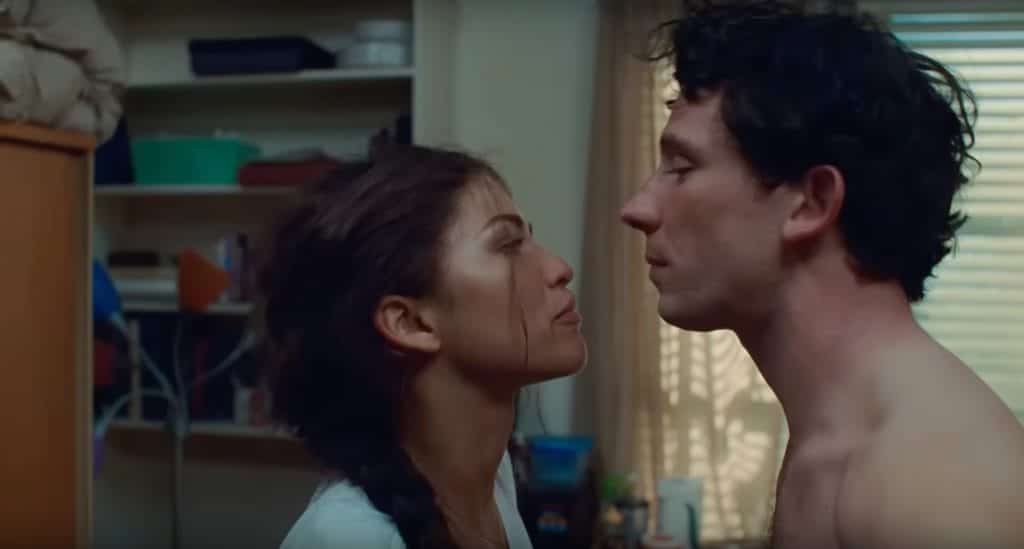
In an instant, Patrick has lost. As indicated by Lily’s complaint to her parents, Art wins the competition for Tashi’s affection because he can engage with Tashi through the medium of tennis. He can facilitate a relationship in which she feels completely understood. Art wins her back definitively by inviting her to be his assistant coach, allowing her to hang on to the world of “hitting a ball with a racquet” despite her injury. Patrick cannot perform this same function. He is far more interested in what a conventional physical relationship with Tashi has to offer than, in his words, having Tashi as his “mentor.”
Here’s the thing: based on what Guadagnino lets the audience see, sex and tennis are mutually exclusive. They perform the same function, but you can’t do both. The relationship between Art and Tashi, built upon the game, is presented as sexless. We do not get the same scenes of physical intimacy between actual husband and wife that we do between Tashi and Patrick. Equally, what we never see between Tashi and Patrick is tennis. They never so much as do a warmup or a drill together, as we see so many times between Art and Tashi.
Here, the significance of Tashi saying that “everyone watching” also “completely understood” the players engaged in a tennis match is brought into play, aided in no small part by the fact that we are able to act as spectators. What we, the audience, see defines the parameters of the relationships in Challengers. Tennis is the same as talking is not the same as fucking, but tennis, done right, is a substitute for fucking. Following? Good.
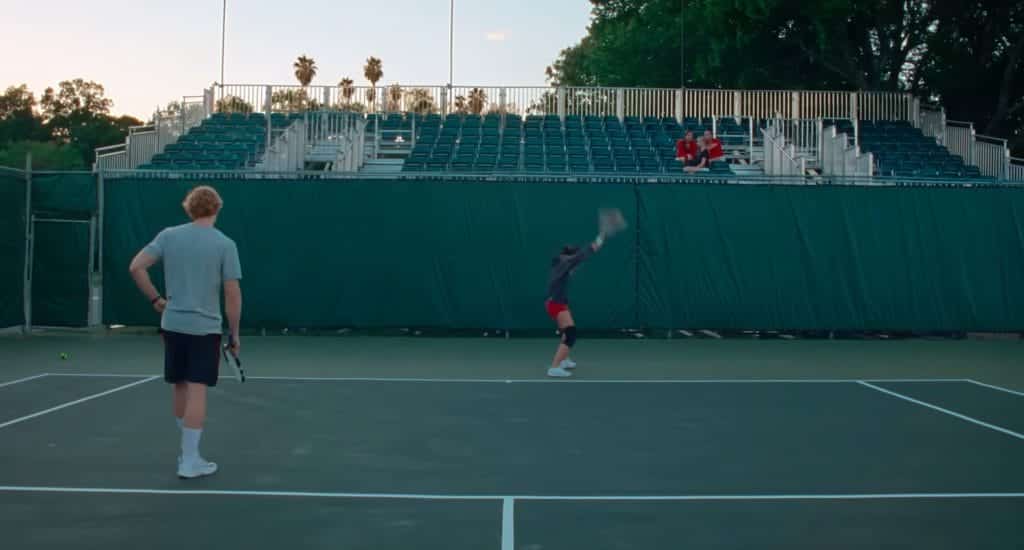
We’re Not Talking About Tennis.
Says Patrick to Art in the sauna at Phil’s Tire Challenger. Now here’s a complicated one.
The movement direction used in Challengers is important in conveying the fluctuations in intimacy in the relationships. When portraying their characters in their younger years, O’Connor and Faist move with uncanny synchronicity. They both recline in their seats at the same time when watching Tashi for the first time. When they are shown hitting together at the Mark Rebellato Tennis Academy, they walk to the court, drop their bags, drop their racquets, and walk onto the court in perfect step. It is almost like ballet.
Fast-forward thirteen years to Phil’s Tire Challenger, and O’Connor and Faist are moving their characters just out of step: they lean back and forth on the benches at different times, still ultimately ending up in the same place, just not having gotten there as cleanly. It is jarring to see, after the heydays of their cohesion.
As Tashi explained: “tennis is a relationship.” If the on-court relationship is lost, so is the personal. In Cincinnati, Art tells Tashi that he and Patrick “haven’t played professionally, and don’t keep in touch.” When Tashi responds, “I am a homewrecker,” you get the sense that she’s reacting more to the admission that Patrick and Art haven’t encountered each other on opposite sides of the net in a while than the fact that they aren’t friends.
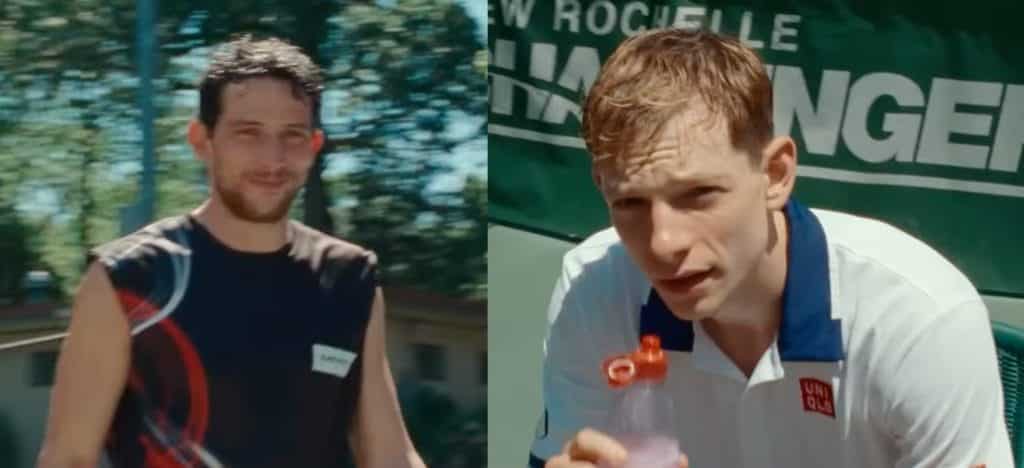
Assisting the presentation of a breakdown in understanding is creative camera work. Guadagnino, in the film’s denouement, plays around with different perspectives. A particularly interesting set of perspective shots is when we see Patrick through Art’s eyes and Art through Patrick’s. Patrick sort of smirks at him. Art is looking nonplussed.
What is so effective here is that the cinematography can reflect different states of being in the know through the use of these first-person shots. The audience understands what this look is about (or so we think) but Art is none the wiser as to Tashi’s dealings with Patrick which took place in the tournament. The camera does not follow Patrick steadily and, as such, Art’s view of Patrick is unclear. Patrick can see Art clear as day.
We Understood Each Other Completely.
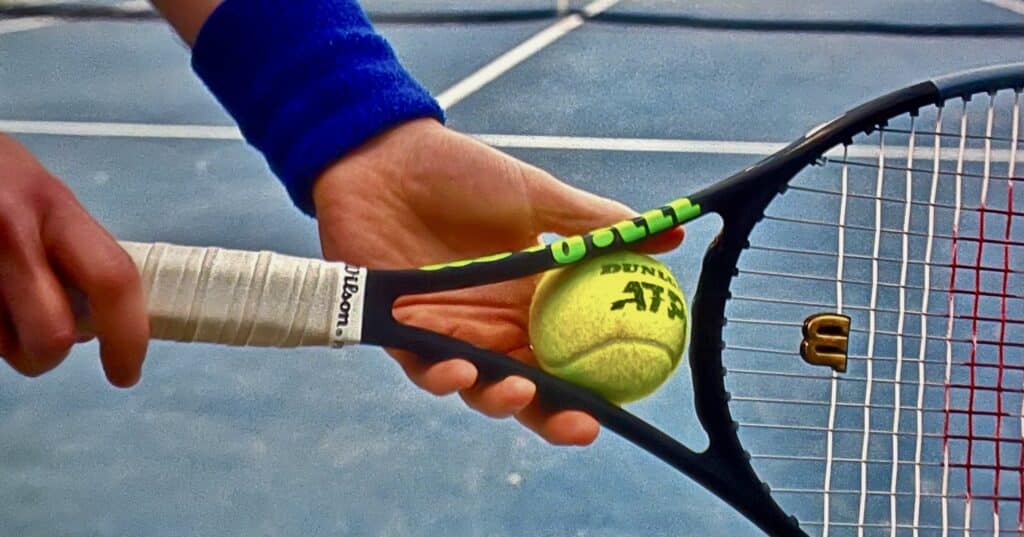
Justin Kuritzkes has stated that he was intrigued by the potential for non-verbal communication in tennis, inspired by Serena Williams’s code violation for communicating with her coach through signs during the 2018 US Open.
Without giving too much away, it is through covert signs that Art and Patrick find themselves back at that state of complete understanding. As they find themselves at match point, Patrick is evidently tired of keeping Art in the dark. They haven’t really been understanding each other. Tashi, then, wouldn’t consider either of them to be playing tennis, but Patrick is ready to play. With his tennis ball and racquet, he signals something to Art, a code between them that has not been forgotten in the twelve years since it was first devised as a meaningful symbol by the pair.
Does Patrick want to hurt Art? No. He knows Art well enough, in the context of the game, to know that they will really be playing tennis if he lets Art in on the secret—and Patrick is absolutely right.
Patrick and Art used to be “talking about tennis,” but Patrick and Art haven’t done so in years. They have lost this relationship; however, by the end of the match, Art and Patrick are back to this state of complete understanding. The relationship has been restored by playing tennis, the greatest testament to the integrity of Tashi’s understanding of what tennis can do.
So, now we’re playing tennis. We’re talking about tennis. We’re working out some pretty hefty resentments through tennis. Let’s go back to something Guadagnino signalled to us right at the start of the trio’s relationship.
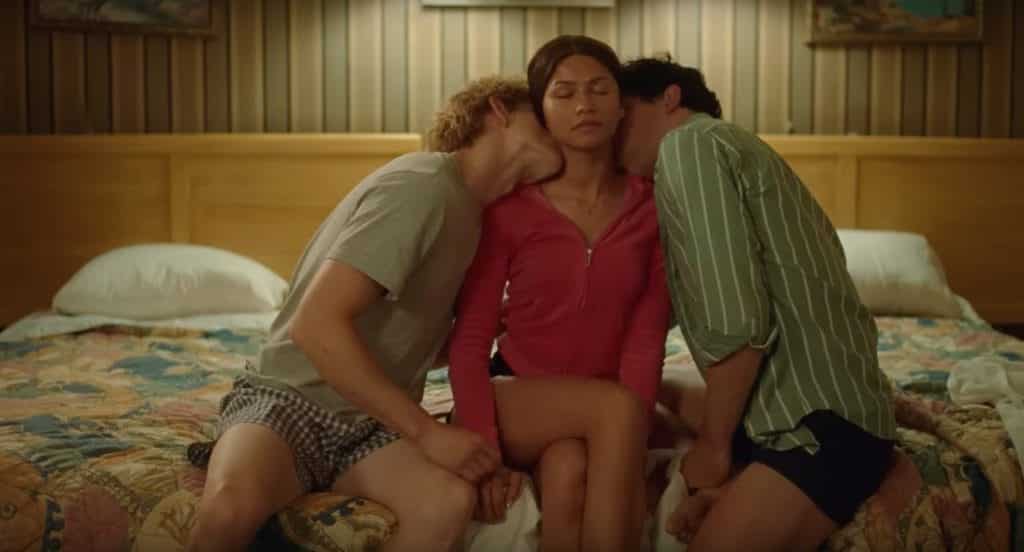
Think of this scene like a tennis court. Tashi is the net. Art and Patrick are the players. We, the moviegoers, are the spectators. Tashi has already mentioned us, the “watchers”: we also “completely” understand the relationship between tennis opponents. Maybe at this point in the film, we don’t quite understand them yet; but, if we hold this image in our minds, everything is made clear to us in the end, just as it is to Art, Tashi, and Patrick.
Art is, from the viewer’s perspective, on the left. Patrick is on the right. Tashi is facing us. The staging of the actors here is tremendously important—it is hard to believe that anything in this movie is incidental. When we get to the climax of the film, match point, Art is on the left of the net, Patrick on the right, and Tashi is in line with the net, staring the viewer down.
Another thing the viewer’s attention is continuously drawn to is the scar on Tashi’s right knee. This is the side Art is on, to her, in their first encounter, and the side he is on when he either wins or loses match point at Phil’s Tire Challenger. The scar represents failure. What have we seen Tashi do in response to failure, so far? It prompts her to stay in the game any way she can.
Art is threatening to retire. Patrick is thinking he can go for at least another year, but only with Tashi’s help. Tashi is delighted with the result, whatever it is. Who won the match? Does it matter? Maybe not: we’re all talking about tennis again, after all.


